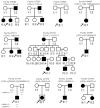Identification of FZD4 and LRP5 mutations in 11 of 49 families with familial exudative vitreoretinopathy
- PMID: 23077402
- PMCID: PMC3472927
Identification of FZD4 and LRP5 mutations in 11 of 49 families with familial exudative vitreoretinopathy
Abstract
Purpose: To identify mutations in FZD4 and LRP5 in 49 Chinese families with familial exudative vitreoretinopathy (FEVR) and to reveal the mutation spectrum and frequency of these genes in the Chinese population.
Methods: Clinical data and genomic DNA were collected for patients from 49 families with FEVR. The coding exons and adjacent intronic regions of FZD4 and LRP5 were amplified with polymerase chain reaction, and the resulting amplicons were analyzed with Sanger sequencing.
Results: Eleven mutations were detected in 11 of the 49 families (22.4%), including five mutations in the FZD4 gene in six families and six mutations in the LRP5 gene in five families. Of the 11 mutations, eight were novel. Two families had the same FZD4 mutation, and one family had compound heterozygous mutations in LRP5. The phenotypes of the patients with the mutations showed great variability.
Conclusions: Our findings provide an overview of the mutation spectrum and frequency of FZD4 and LRP5 in Chinese patients with FEVR and emphasize the complexity of FEVR mutations and phenotypes.
Figures




References
-
- Criswick VG, Schepens CL. Familial exudative vitreoretinopathy. Am J Ophthalmol. 1969;68:578–94. - PubMed
-
- van Nouhuys CE. Signs, complications, and platelet aggregation in familial exudative vitreoretinopathy. Am J Ophthalmol. 1991;111:34–41. - PubMed
-
- Robitaille J, MacDonald ML, Kaykas A, Sheldahl LC, Zeisler J, Dube MP, Zhang LH, Singaraja RR, Guernsey DL, Zheng B, Siebert LF, Hoskin-Mott A, Trese MT, Pimstone SN, Shastry BS, Moon RT, Hayden MR, Goldberg YP, Samuels ME. Mutant frizzled-4 disrupts retinal angiogenesis in familial exudative vitreoretinopathy. Nat Genet. 2002;32:326–30. - PubMed
-
- Toomes C, Bottomley HM, Jackson RM, Towns KV, Scott S, Mackey DA, Craig JE, Jiang L, Yang Z, Trembath R, Woodruff G, Gregory-Evans CY, Gregory-Evans K, Parker MJ, Black GC, Downey LM, Zhang K, Inglehearn CF. Mutations in lrp5 or fzd4 underlie the common familial exudative vitreoretinopathy locus on chromosome 11q. Am J Hum Genet. 2004;74:721–30. - PMC - PubMed
Publication types
MeSH terms
Substances
Supplementary concepts
LinkOut - more resources
Full Text Sources
